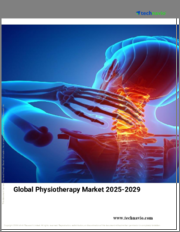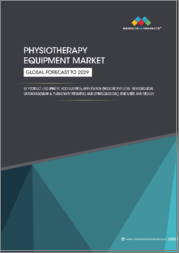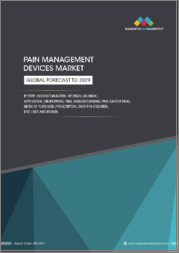
|
시장보고서
상품코드
1520521
세계의 물리치료 장비 시장 보고서 : 제품, 용도, 최종 사용자, 지역별(2024-2032년)Physiotherapy Equipment Market Report by Product, Application, End-User, and Region 2024-2032 |
||||||
세계의 물리치료 장비 시장 규모는 2023년 188억 달러에 달했습니다. 앞으로 IMARC 그룹은 2024년과 2032년 사이에 5.4%의 복합 연간 성장률(CAGR)을 보일 전망이며, 2032년까지 306억 달러에 이를 것으로 예측했습니다. 대중에서 만성 질환의 만연, 비침습적 치료에 대한 수요가 증가하고, 신흥 건강 관리 산업이 시장을 견인하는 주요 요인 중 하나입니다.
물리치료 장비란 신체장애, 장애, 통증의 진단, 치료, 예방을 하는 헬스케어의 한 분야인 물리치료의 실천에 이용되는 폭넓은 툴과 기계를 말합니다. 운동, 마사지, 스트레칭, 전기 자극 등 물리치료사가 환자에게 다양한 치료를 할 때 도움이되도록 설계되었습니다. 또, 형상이나 사이즈도 다양하고, 치료용과 진단용의 2유형로 대별됩니다. 치료 장비는 초음파 치료기, 전기 근육 자극 장치, 온열 및 얼음 치료기, 디딜방아, 가중치, 저항 밴드와 같은 운동 장비와 같은 환자에게 특정 치료를 제공하도록 설계되었습니다. 한편, 진단 장비는 보행 분석 시스템, 모션 캡처 카메라, 다양한 유형의 모니터링 장비 및 영상 장비와 같은 신체 장애 및 장애를 진단하는 데 사용됩니다. 기타 물리치료 장비에는 견인장치와 밸런스보드 등이 있어 척추의 스트레치나 제압에 사용되어 환자의 밸런스 감각과 안정성 향상에 도움이 됩니다. 게다가 많은 물리치료 클리닉은 환자의 진행 상황을 추적, 생체감시 및 치료 계획을 관리하는 데 도움이 되는 컴퓨터화된 시스템을 사용합니다.
물리치료 장비 시장 동향 :
건강 관리 지출 증가가 시장을 견인하고 있습니다. 이것은 대중들 사이에서 근골격계 질환, 신경질환, 심혈관질환 등의 만성질환의 유병률이 상승하고 있는 것이 배경에 있습니다. 이와 함께 비침습적인 치료에 대한 수요 증가가 세계의 물리치료 장비 수요를 촉진하고 있습니다. 이에 따라 초음파장치, 전기자극장치, 견인장치 등 많은 물리치료 장비는 비침습적이며 개인들 사이에서 널리 선호되기 때문에 시장에 더욱 영향을 미치고 있습니다. 세계의 고령화에 따라 관절염, 골다공증, 관절통 등 노화에 따른 증상의 치료에 도움이 되는 물리치료 장비 수요가 급속히 높아지고 있으며, 이는 수요를 자극하고 있습니다. 게다가 노인이 되어도 운동 능력, 근력, 유연성을 유지할 수 있는 물리치료의 장점에 대한 인식이 높아지고 있는 것도 물리치료 장비 시장을 견인하고 있습니다. 이와는 별도로 휴대용으로 사용하기 쉬운 물리치료 장비를 널리 이용할 수 있게 됨으로써 환자가 집에서 치료를 받을 수 있게 되어, 통원의 필요성이 줄어들고, 환자의 치료 성적이 향상되어 어떤 것도 시장에 영향을 미칩니다. 또한 인공지능(AI), 가상현실(VR), 첨단기술을 물리치료 장비에 통합함으로써 환자에 의해 개별화된 효과적인 치료를 제공할 수 있게 되어 시장 전망이 밝아지고 있습니다. 시장을 견인하는 다른 요인으로는 지속적인 기술 진보와 건강 관리 분야의 급속한 개선 등이 있습니다.
목차
제1장 서문
제2장 조사 범위와 조사 방법
- 조사의 목적
- 이해관계자
- 데이터 소스
- 1차 정보
- 2차 정보
- 시장 추정
- 상향식 접근
- 하향식 접근
- 조사 방법
제3장 주요 요약
제4장 소개
- 개요
- 주요 업계 동향
제5장 세계의 물리치료 장비 시장
- 시장 개요
- 시장 실적
- COVID-19의 영향
- 시장 예측
제6장 시장 분석 : 제품별
- 장치
- 시장 동향
- 주요 유형
- 전기요법 기기
- 초음파 기기
- 운동요법 기기
- 동결요법 기기
- 복합치료 기기
- 기타
- 시장 예측
- 부속품
- 시장 동향
- 시장 예측
제7장 시장 분석 : 용도별
- 근골격
- 시장 동향
- 시장 예측
- 신경
- 시장 동향
- 시장 예측
- 심장혈관과 폐
- 시장 동향
- 시장 예측
- 소아과
- 시장 동향
- 시장 예측
- 부인과
- 시장 동향
- 시장 예측
- 기타
- 시장 동향
- 시장 예측
제8장 시장 분석 : 최종사용자별
- 병원
- 시장 동향
- 시장 예측
- 재활센터/클리닉
- 시장 동향
- 시장 예측
- 주택
- 시장 동향
- 시장 예측
- 기타
- 시장 동향
- 시장 예측
제9장 시장 분석 : 지역별
- 북미
- 미국
- 캐나다
- 아시아태평양
- 중국
- 일본
- 인도
- 한국
- 호주
- 인도네시아
- 기타
- 유럽
- 독일
- 프랑스
- 영국
- 이탈리아
- 스페인
- 러시아
- 기타
- 라틴아메리카
- 브라질
- 멕시코
- 기타
- 중동 및 아프리카
- 시장 동향
- 시장 분석 : 국가별
- 시장 예측
제10장 SWOT 분석
- 개요
- 강점
- 약점
- 기회
- 위협
제11장 밸류체인 분석
- 개요
- 인바운드 물류
- 오퍼레이션
- 출하 물류
- 마케팅 및 판매
- 애프터 서비스
제12장 Porter's Five Forces 분석
- 개요
- 구매자의 협상력
- 공급기업의 협상력
- 경쟁도
- 신규 참가업체의 위협
- 대체품의 위협
제13장 가격 지표
제14장 경쟁 구도
- 시장 구조
- 주요 기업
- 주요 기업 프로파일
- DJO Global, Inc.
- EMS Physio Ltd.
- ENRAF-NONIUS BV
- BTL Industries, Inc.
- Zynex Inc.
- ITO Co. Ltd.
- Mectronic Medicale Srl
- Whitehall Manufacturing(Morris Group International, Inc.)
The global physiotherapy equipment market size reached US$ 18.8 Billion in 2023. Looking forward, IMARC Group expects the market to reach US$ 30.6 Billion by 2032, exhibiting a growth rate (CAGR) of 5.4% during 2024-2032. The growing prevalence of chronic diseases among the masses, the rising demand for non-invasive treatments, and the emerging healthcare industry represent some of the key factors driving the market.
Physiotherapy equipment refers to a wide range of tools and machines that are utilized in the practice of physiotherapy, a branch of healthcare that involves the diagnosis, treatment, and prevention of physical impairments, disabilities, and pain. It is designed to aid physiotherapists in providing patients with various forms of treatment, including exercise, massage, stretching, electrical stimulation, and more. Additionally, it comes in several shapes and sizes and can be broadly categorized into two main types, such as therapeutic and diagnostic. Therapeutic equipment is designed to provide specific forms of treatment to patients, including ultrasound machines, electric muscle stimulators, heat and ice therapy machines, and exercise equipment like treadmills, weights, and resistance bands. On the contrary, diagnostic equipment is adopted to diagnose physical impairments and disorders, such as gait analysis systems, motion capture cameras, and different types of monitoring and imaging equipment. Other types of physiotherapy equipment include traction devices and balance boards, which are used to stretch and decompress the spine and help patients improve their balance and stability. In addition, numerous physiotherapy clinics also use computerized systems to help patients track their progress, monitor their vitals, and manage their treatment plans.
Physiotherapy Equipment Market Trends:
The escalating healthcare expenditure majorly drives the global market. This can be supported by the rising prevalence of chronic diseases, such as musculoskeletal disorders, neurological disorders, and cardiovascular diseases among the masses. Along with this, the growing demand for non-invasive treatments is driving the demand for physiotherapy equipment across the globe. In line with this, numerous physiotherapy equipment, such as ultrasound machines, electric stimulation devices, and traction machines are non-invasive and are widely preferred among individuals, which is further impacting the market. With the aging population across the globe, the demand for physiotherapy equipment has rapidly increased that helps in treating age-related conditions, including arthritis, osteoporosis, and joint pain, is catalyzing the demand. Moreover, the rising awareness regarding the benefits of physiotherapy in maintaining mobility, strength, and flexibility in old age, is also driving the market for physiotherapy equipment. Apart from this, the wide availability of portable and easy-to-use physiotherapy equipment is enabling patients to receive treatment at home, reducing the need for hospital visits and improving patient outcomes, which, in turn, is impacting the market. Furthermore, the integration of artificial intelligence (AI), virtual reality (VR), and advanced technologies with physiotherapy equipment to provide more personalized and effective treatments to patients is creating a positive market outlook. Some of the other factors driving the market include continual technological advancements and rapid improvements in the healthcare sector.
Key Market Segmentation:
IMARC Group provides an analysis of the key trends in each sub-segment of the global physiotherapy equipment market report, along with forecasts at the global, regional and country levels from 2024-2032. Our report has categorized the market based on product, application and end-user.
Product Insights:
Equipment
Electrotherapy Equipment
Ultrasound Equipment
Exercise Therapy Equipment
Cryotherapy Equipment
Combination Therapy Equipment
Others
Accessories
The report has provided a detailed breakup and analysis of the physiotherapy equipment market based on the product. This includes equipment (electrotherapy equipment, ultrasound equipment, exercise therapy equipment, cryotherapy equipment, combination therapy equipment, and others), and accessories. According to the report, equipment represented the largest segment.
Application Insights:
Musculoskeletal
Neurological
Cardiovascular and Pulmonary
Pediatric
Gynecological
Others
A detailed breakup and analysis of the physiotherapy equipment market based on the application have also been provided in the report. This includes musculoskeletal, neurological, cardiovascular and pulmonary, pediatric, gynecological, and others. According to the report, musculoskeletal accounted for the largest market.
End-User Insights:
Hospitals
Rehabilitation Centers/Clinics
Homes
Others
The report has provided a detailed breakup and analysis of the physiotherapy equipment market based on the end-user. This includes hospitals, rehabilitation centers/clinics, homes, and others. According to the report, hospitals represented the largest segment.
Regional Insights:
North America
United States
Canada
Asia Pacific
China
Japan
India
South Korea
Australia
Indonesia
Others
Europe
Germany
France
United Kingdom
Italy
Spain
Russia
Others
Latin America
Brazil
Mexico
Others
Middle East and Africa
The report has also provided a comprehensive analysis of all the major regional markets, which include North America (the United States and Canada); Asia Pacific (China, Japan, India, South Korea, Australia, Indonesia, and others); Europe (Germany, France, the United Kingdom, Italy, Spain, Russia, and others); Latin America (Brazil, Mexico, and others); and the Middle East and Africa. According to the report, North America was the largest market for physiotherapy equipment. Some of the factors driving the North America physiotherapy equipment market included continual technological advancements and the presence of large players.
Competitive Landscape:
The report has also provided a comprehensive analysis of the competitive landscape in the global physiotherapy equipment market. Competitive analysis such as market structure, market share by key players, player positioning, top winning strategies, competitive dashboard, and company evaluation quadrant has been covered in the report. Also, detailed profiles of all major companies have been provided. Some of the companies covered include DJO Global, Inc., EMS Physio Ltd., ENRAF-NONIUS B.V., BTL Industries, Inc., Zynex Inc., ITO Co. Ltd., Mectronic Medicale S.r.l. and Whitehall Manufacturing (Morris Group International, Inc.).
Key Questions Answered in This Report:
- How has the global physiotherapy equipment market performed so far, and how will it perform in the coming years?
- What are the drivers, restraints, and opportunities in the global physiotherapy equipment market?
- What is the impact of each driver, restraint, and opportunity on the global physiotherapy equipment market?
- What are the key regional markets?
- Which countries represent the most attractive physiotherapy equipment market?
- What is the breakup of the market based on the product?
- Which is the most attractive product in the physiotherapy equipment market?
- What is the breakup of the market based on the application?
- Which is the most attractive application in the physiotherapy equipment market?
- What is the breakup of the market based on the end-user?
- Which is the most attractive end-user in the physiotherapy equipment market?
- What is the competitive structure of the global physiotherapy equipment market?
- Who are the key players/companies in the global physiotherapy equipment market?
Table of Contents
1 Preface
2 Scope and Methodology
- 2.1 Objectives of the Study
- 2.2 Stakeholders
- 2.3 Data Sources
- 2.3.1 Primary Sources
- 2.3.2 Secondary Sources
- 2.4 Market Estimation
- 2.4.1 Bottom-Up Approach
- 2.4.2 Top-Down Approach
- 2.5 Forecasting Methodology
3 Executive Summary
4 Introduction
- 4.1 Overview
- 4.2 Key Industry Trends
5 Global Physiotherapy Equipment Market
- 5.1 Market Overview
- 5.2 Market Performance
- 5.3 Impact of COVID-19
- 5.4 Market Forecast
6 Market Breakup by Product
- 6.1 Equipment
- 6.1.1 Market Trends
- 6.1.2 Major Types
- 6.1.2.1 Electrotherapy Equipment
- 6.1.2.2 Ultrasound Equipment
- 6.1.2.3 Exercise Therapy Equipment
- 6.1.2.4 Cryotherapy Equipment
- 6.1.2.5 Combination Therapy Equipment
- 6.1.2.6 Others
- 6.1.3 Market Forecast
- 6.2 Accessories
- 6.2.1 Market Trends
- 6.2.2 Market Forecast
7 Market Breakup by Application
- 7.1 Musculoskeletal
- 7.1.1 Market Trends
- 7.1.2 Market Forecast
- 7.2 Neurological
- 7.2.1 Market Trends
- 7.2.2 Market Forecast
- 7.3 Cardiovascular and Pulmonary
- 7.3.1 Market Trends
- 7.3.2 Market Forecast
- 7.4 Pediatric
- 7.4.1 Market Trends
- 7.4.2 Market Forecast
- 7.5 Gynecological
- 7.5.1 Market Trends
- 7.5.2 Market Forecast
- 7.6 Others
- 7.6.1 Market Trends
- 7.6.2 Market Forecast
8 Market Breakup by End-User
- 8.1 Hospitals
- 8.1.1 Market Trends
- 8.1.2 Market Forecast
- 8.2 Rehabilitation Centers/Clinics
- 8.2.1 Market Trends
- 8.2.2 Market Forecast
- 8.3 Homes
- 8.3.1 Market Trends
- 8.3.2 Market Forecast
- 8.4 Others
- 8.4.1 Market Trends
- 8.4.2 Market Forecast
9 Market Breakup by Region
- 9.1 North America
- 9.1.1 United States
- 9.1.1.1 Market Trends
- 9.1.1.2 Market Forecast
- 9.1.2 Canada
- 9.1.2.1 Market Trends
- 9.1.2.2 Market Forecast
- 9.1.1 United States
- 9.2 Asia Pacific
- 9.2.1 China
- 9.2.1.1 Market Trends
- 9.2.1.2 Market Forecast
- 9.2.2 Japan
- 9.2.2.1 Market Trends
- 9.2.2.2 Market Forecast
- 9.2.3 India
- 9.2.3.1 Market Trends
- 9.2.3.2 Market Forecast
- 9.2.4 South Korea
- 9.2.4.1 Market Trends
- 9.2.4.2 Market Forecast
- 9.2.5 Australia
- 9.2.5.1 Market Trends
- 9.2.5.2 Market Forecast
- 9.2.6 Indonesia
- 9.2.6.1 Market Trends
- 9.2.6.2 Market Forecast
- 9.2.7 Others
- 9.2.7.1 Market Trends
- 9.2.7.2 Market Forecast
- 9.2.1 China
- 9.3 Europe
- 9.3.1 Germany
- 9.3.1.1 Market Trends
- 9.3.1.2 Market Forecast
- 9.3.2 France
- 9.3.2.1 Market Trends
- 9.3.2.2 Market Forecast
- 9.3.3 United Kingdom
- 9.3.3.1 Market Trends
- 9.3.3.2 Market Forecast
- 9.3.4 Italy
- 9.3.4.1 Market Trends
- 9.3.4.2 Market Forecast
- 9.3.5 Spain
- 9.3.5.1 Market Trends
- 9.3.5.2 Market Forecast
- 9.2.6 Russia
- 9.2.6.1 Market Trends
- 9.2.6.2 Market Forecast
- 9.2.7 Others
- 9.2.7.1 Market Trends
- 9.2.7.2 Market Forecast
- 9.3.1 Germany
- 9.4 Latin America
- 9.4.1 Brazil
- 9.4.1.1 Market Trends
- 9.4.1.2 Market Forecast
- 9.4.2 Mexico
- 9.4.2.1 Market Trends
- 9.4.2.2 Market Forecast
- 9.4.3 Others
- 9.4.3.1 Market Trends
- 9.4.3.2 Market Forecast
- 9.4.1 Brazil
- 9.5 Middle East and Africa
- 9.5.1 Market Trends
- 9.5.2 Market Breakup by Country
- 9.5.3 Market Forecast
10 SWOT Analysis
- 10.1 Overview
- 10.2 Strengths
- 10.3 Weaknesses
- 10.4 Opportunities
- 10.5 Threats
11 Value Chain Analysis
- 11.1 Overview
- 11.2 Inbound Logistics
- 11.3 Operations
- 11.4 Outbound Logistics
- 11.5 Marketing and Sales
- 11.6 Post Sales Services
12 Porters Five Forces Analysis
- 12.1 Overview
- 12.2 Bargaining Power of Buyers
- 12.3 Bargaining Power of Suppliers
- 12.4 Degree of Competition
- 12.5 Threat of New Entrants
- 12.6 Threat of Substitutes
13 Price Indicators
14 Competitive Landscape
- 14.1 Market Structure
- 14.2 Key Players
- 14.3 Profiles of Key Players
- 14.3.1 DJO Global, Inc.
- 14.3.1.1 Company Overview
- 14.3.1.2 Product Portfolio
- 14.3.2 EMS Physio Ltd.
- 14.3.2.1 Company Overview
- 14.3.2.2 Product Portfolio
- 14.3.3 ENRAF-NONIUS B.V.
- 14.3.3.1 Company Overview
- 14.3.3.2 Product Portfolio
- 14.3.4 BTL Industries, Inc.
- 14.3.4.1 Company Overview
- 14.3.4.2 Product Portfolio
- 14.3.5 Zynex Inc.
- 14.3.5.1 Company Overview
- 14.3.5.2 Product Portfolio
- 14.3.6 ITO Co. Ltd.
- 14.3.6.1 Company Overview
- 14.3.6.2 Product Portfolio
- 14.3.7 Mectronic Medicale S.r.l.
- 14.3.7.1 Company Overview
- 14.3.7.2 Product Portfolio
- 14.3.8 Whitehall Manufacturing (Morris Group International, Inc.)
- 14.3.8.1 Company Overview
- 14.3.8.2 Product Portfolio
- 14.3.1 DJO Global, Inc.



















